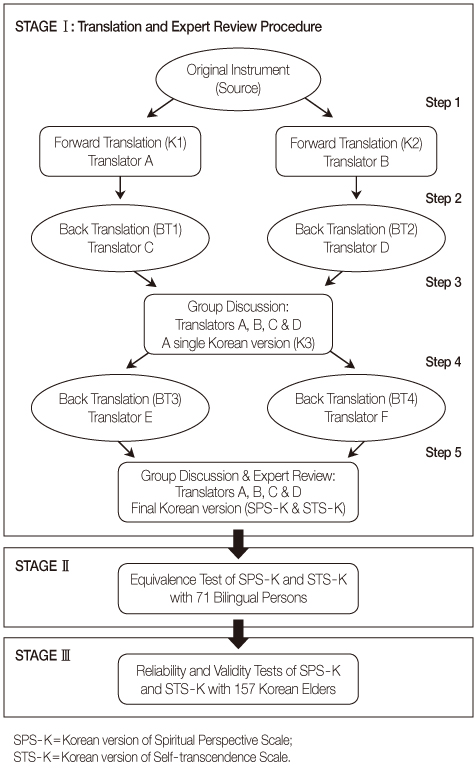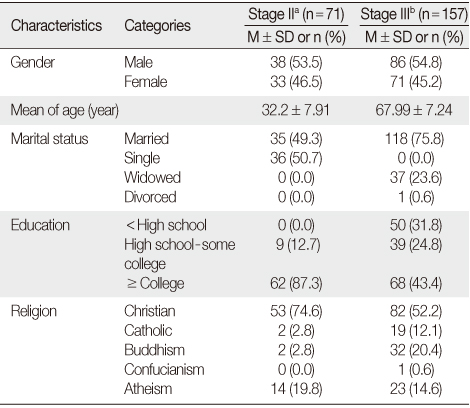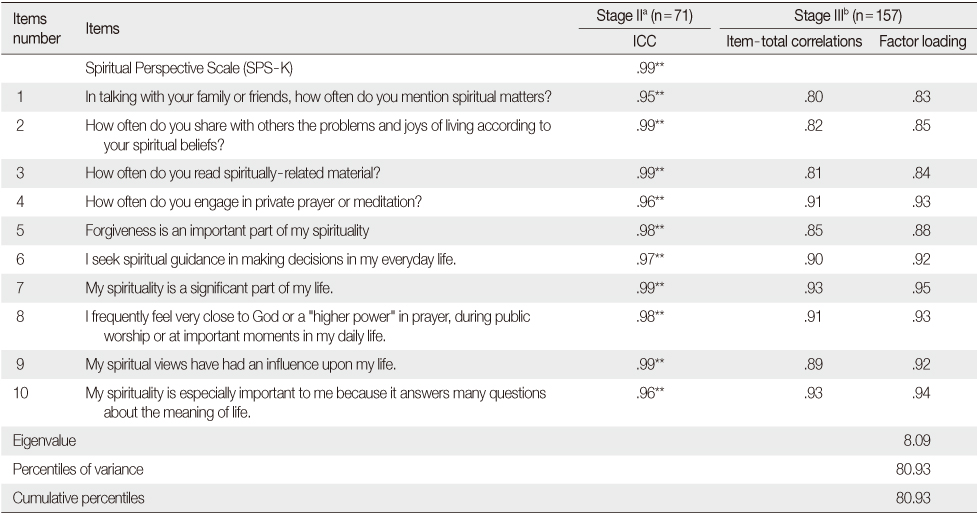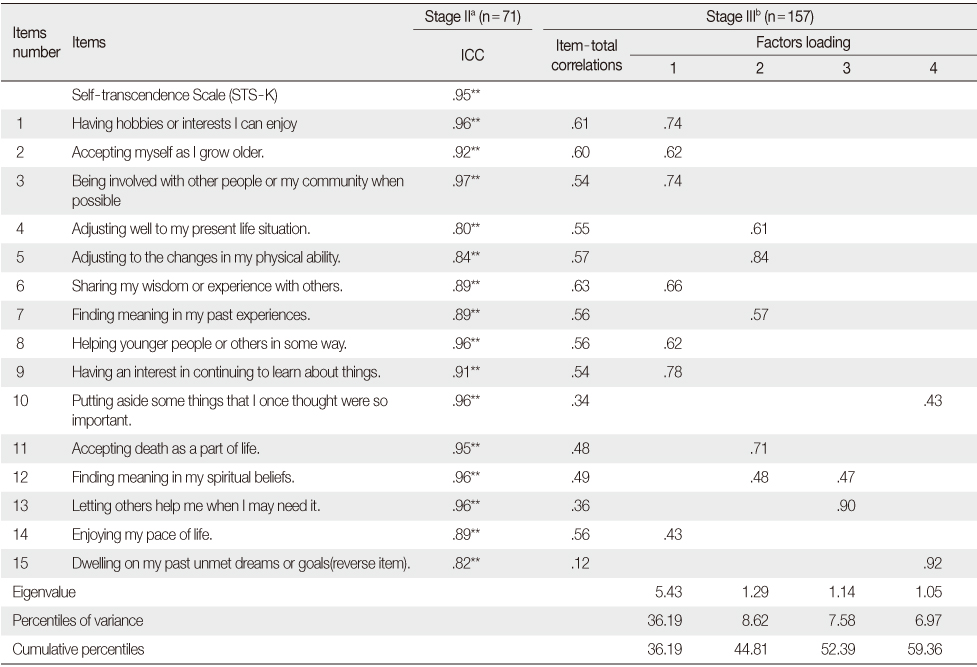Articles
- Page Path
- HOME > J Korean Acad Nurs > Volume 42(7); 2012 > Article
-
Original Article
- Translation and Psychometric Testing of the Korean Versions of the Spiritual Perspective Scale and the Self-transcendence Scale in Korean Elders
- Suk-Sun Kim, Pamela G. Reed, Youngmi Kang, Jina Oh
-
Journal of Korean Academy of Nursing 2012;42(7):974-983.
DOI: https://doi.org/10.4040/jkan.2012.42.7.974
Published online: December 31, 2012
1School of Nursing, College of Health and Human Services, George Mason University, Fairfax, Virginia, USA.
2College of Nursing, University of Arizona, Tucson, Arizona, USA.
3The Carolyn McKelvey Moore School of Nursing, College of Health Sciences, University of Arkansas at Fort Smith, Fort Smith, Arkansas, USA.
4Department of Nursing, Institute of Health Science, Inje University, Busan, Korea.
- Address reprint requests to: Kim, Suk-Sun. School of Nursing, College of Health and Human Services, George Mason University, 4400 University Drive, Fairfax, Virginia, USA. Tel: +1-703-993-1901, Fax: +1-703-993-1949, suksunkim@gmail.com
© 2012 Korean Society of Nursing Science
- 1,120 Views
- 19 Download
- 29 Crossref
Abstract
-
Purpose
- The purpose of this study was to translate the Spiritual Perspective Scale (SPS) and Self-transcendence Scale (STS) into Korean and test the psychometric properties of the instruments with Korean elders.
-
Methods
- A cross-sectional survey design was used to implement the three stages of the study. Stage I consisted of translating and reviewing the scales by six experts. In Stage II, equivalence was tested by comparing the responses between the Korean and English versions among 71 bilingual adults. Stage III established the psychometric properties of the Korean versions SPS-K and STS-K among 154 Korean elders.
-
Results
- Cronbach's alpha of the SPS-K and the STS-K .97, and .85 respectively with Korean elders. Factor analysis showed that the SPS-K had one factor; the STS-K had four factors with one factor clearly representing self-transcendence as theorized. Both scales showed good reliability and validity for the translated Korean versions. However, continued study of the construct validity of the STS-K is needed.
-
Conclusion
- Study findings indicate that the SPS-K and the STS-K could be useful for nurses and geriatric researchers to assess a broadly defined spirituality, and to conduct research on spirituality and health among Korean elders. Use of these scales within a theory-based study may contribute to further knowledge about the role of spirituality in the health and well-being of Korean people facing health crises.
INTRODUCTION
METHODS
1) Spiritual Perspective Scale (SPS)
2) Self-transcendence Scale (STS)
1) Stage I: Translation and expert review
2) Stage II: Equivalence test using response comparisons in bilingual persons
(1) Sample and procedure
(2) Data analysis
3) Stage III: Psychometric tests in Korean elders
(1) Sample and procedure
(2) Data analysis
RESULTS
1) Participants' characteristics
2) Reliability
3) Equivalence
1) Participants' characteristics
2) Reliability
3) Construct validity
4) Convergent validity
DISCUSSION
CONCLUSION
This article is a part of the doctoral dissertation research of the first author.
It is supported by the Susie Dissertation Research Fellowship from the Global Korean Nursing Foundation (GKNF).
- 1. Bean KB, Wagner K. Self-transcendence, illness distress, and quality of life among liver transplant recipients. J Theory Constr Test. 2006;10(2):47–53.
- 2. Berry JW. On cross-cultural comparability. Int J Psychol. 1969;4(2):119–128. http://dx.doi.org/10.1080/00207596908247261.Article
- 3. Boswell GH, Kahana E, Dilworth-Anderson P. Spirituality and health lifestyle behaviors: Stress counter-balancing effects on the well-being of older adults. J Relig Health. 2006;45(4):587–602. http://dx.doi.org/10.1007/s10943-006-9060-7.ArticlePDF
- 4. Brislin RW. Back-translation for cross-cultural research. J Cross Cult Psychol. 1970;1(3):185–216. http://dx.doi.org/10.1177/135910457000100301.ArticlePDF
- 5. Callen BL, Mefford L, Groer M, Thomas SP. Relationships among stress, infectious illness, and religiousness/spirituality in community-dwelling older adults. Res Gerontol Nurs. 2011;4(3):195–206. http://dx.doi.org/10.3928/19404921-20101001-99.ArticlePubMed
- 6. Chen S, Walsh SM. Effect of a creative-bonding intervention on Taiwanese nursing students' self-transcendence and attitudes toward elders. Res Nurs Health. 2009;32:204–216. http://dx.doi.org/10.1002/nur.20310.ArticlePubMed
- 7. Dailey DE, Steward AL. Psychometric characteristics of the Spiritual Perspective Scale in pregnant African-American women. Res Nurs Health. 2007;30:61–71. http://dx.doi.org/10.1002/nur.20173.ArticlePubMed
- 8. Delaney C, Barrere C, Helming M. The influence of a spirituality-based intervention on quality of life, depression, and anxiety in community-dwelling adults with cardiovascular disease: A pilot study. J Holist Nurs. 2011;29(1):21–32. http://dx.doi.org/10.1177/0898010110378356.ArticlePubMedPDF
- 9. Floyd FJ, Widaman KF. Factor analysis in the development and refinement of clinical assessment instruments. Psychol Assess. 1995;7:286–299. http://dx.doi.org/10.1037/1040-3590.7.3.286.Article
- 10. George D, Mallery P. SPSS for windows step by step: A simple guide and reference. 18.0 update. 2011;11th ed. Boston, MA, Allyn & Bacon.
- 11. Gray J. Measuring spirituality: Conceptual and methodological considerations. J Theory Constr Test. 2006;10(2):58–64.
- 12. Hilton A, Skrutkowski M. Translating instruments into other languages: Development and testing processes. Cancer Nurs. 2002;25(1):1–7. http://dx.doi.org/10.1097/00002820-200202000-00001.ArticlePubMed
- 13. Hoshi M. Self-transcendence, vulnerability, and well-being in hospitalized Japanese elders. 2008;Tucson, USA, University of Arizona. Unpublished doctoral dissertation.
- 14. Jang E, Kim S. Study on spiritual well-being of elderly people in the community. J Korean Gerontol Nurs. 2003;5(2):193–204.
- 15. Jesse DE, Reed PG. Effects of spirituality and psychosocial well-being on health risk behaviors in Appalachian pregnant women. J Obstet Gynecol Neonatal Nurs. 2004;33:739–747. http://dx.doi.org/10.1177/0884217504270669.ArticlePubMed
- 16. Jones PS, Lee JW, Phillips LR, Zhang XE, Jaceldo KB. An adaptation of Brislin's translation model for cross-cultural research. Nurs Res. 2001;50(5):300–304. http://dx.doi.org/10.1097/00006199-200109000-00008.ArticlePubMed
- 17. Kim SS, Reed PG, Hayward RD, Kang Y, Koenig HG. Spirituality and psychological well-being: Testing a theory of family interdependence among family caregivers and their elders. Res Nurs Health. 2011;34:103–115. http://dx.doi.org/10.1002/nur.20425.ArticlePubMedPDF
- 18. Koenig HG. Concerns about measuring "spirituality" in research. J Nerv Ment Dis. 2008;196(5):349–355. http://dx.doi.org/10.1097/NMD.0b013e31816ff796.ArticlePubMed
- 19. Lee EO. Religion and spirituality as predictors of well-being among Chinese American and Korean American older adults. J Relig Spiritual Aging. 2007;19(3):77–100. http://dx.doi.org/10.1300/J496v19n03_06.Article
- 20. Lee SO, Oh BJ. A correlation study of health promoting behaviors, spiritual well-being and physical function in elderly people. J Korean Gerontol Nurs. 2003;5(2):127–137.
- 21. Nygren B, Aléx L, Jonsén E, Gustafson Y, Norberg A, Lundman B.. Resilience, sense of coherence, purpose in life and self-transcendence in relation to perceived physical and mental health among the oldest old. Aging Ment Health. 2005;9(4):354–362. http://dx.doi.org/10.1080/1360500114415.ArticlePubMed
- 22. Oak S. Healing and exorcism: Christian encounters with shamanism in early modern Korea. Asian Ethnol. 2010;69(1):95–128.
- 23. Paloutzian RF, Ellison CW. Peplau LA, Perlman D. Loneliness, spiritual well-being and the quality of life. In: Loneliness: A sourcebook of current theory, research, and therapy. 1982;New York, John Wiley & Sons.
- 24. Reed PG. Religiousness among terminally ill and healthy adults. Res Nurs Health. 1986;9(1):35–41. http://dx.doi.org/10.1002/nur.4770090107.ArticlePubMed
- 25. Reed PG. Spirituality and well-being in terminally ill hospitalized adults. Res Nurs Health. 1987;10:335–344. http://dx.doi.org/10.1002/nur.4770100507.ArticlePubMed
- 26. Reed PG. Self-transcendence and mental health in oldest-old adults. Nurs Res. 1991;40:5–11. http://dx.doi.org/10.1097/00006199-199101000-00002.PubMed
- 27. Reed PG. Smith MJ, Liehr PR. Self-transcendence theory. In: Middle range theory for nursing. 2008;New York, Springer. 105–130.
- 28. Rohani C, Khanjari S, Abedi HA, Oskouie F, Langius-Eklof A. Health index, sense of coherence scale, brief religious coping scale and spiritual perspective scale: Psychometric properties. J Adv Nurs. 2010;66(12):2796–2806. http://dx.doi.org/10.1111/j.1365-2648.2010.05409.x.ArticlePubMed
- 29. Sessanna L, Finnell D, Jezewski MA. Spirituality in nursing and health-related literature. J Holist Nurs. 2007;25(4):252–262. http://dx.doi.org/10.1177/0898010107303890.ArticlePubMedPDF
- 30. Thomas JC, Burton M, Quinn Griffin MT, Fitzpatrick JJ. Self-transcendence, spiritual well-being, and spiritual practices of women with breast cancer. J Holist Nurs. 2010;28:115–122. http://dx.doi.org/10.1177/0898010109358766.ArticlePubMedPDF
REFERENCES
Figure & Data
REFERENCES
Citations

- Association of spirituality and quality of life in cancer survivors: a systematic review and meta-analysis
Jenny L. Firkins, Ivana Tomic, Lissi Hansen, Christopher D. Woodrell
Supportive Care in Cancer.2025;[Epub] CrossRef - A Structural Equation Model of Resilience in Patients Undergoing Lung Cancer Surgery During the Acute Survival Phase: A Cross-Sectional Study
Miri Kim
Journal of Korean Academy of Fundamentals of Nursing.2025; 32(2): 174. CrossRef - Psychometric evaluation of the spiritual perspective scale for adolescents and young adults with cancer
Chin-Mi Chen, Heeyeon Son, Yvonne Yueh-Feng Lu, Li-Min Wu
Asia-Pacific Journal of Oncology Nursing.2024; 11(11): 100594. CrossRef
Experimental and Clinical Transplantation.2024;[Epub] CrossRef- Effects of Depression, Anxiety, and Self-transcendence on Suicidal Behavior in Community-Dwelling Older Adults
Hee-Sook Kim, Pan-Heui Kim, Gyeong-Ran Park
Journal of Digital Contents Society.2024; 25(4): 971. CrossRef - Pattern of Medication Adherence, Spirituality and Viral Load amongst Adult Patients on Highly Active Antiretroviral Therapy in Rural Southwest Nigeria
Moronkeji Temitope Olanrewaju, Olatutu Ololade Olanrewaju, Azeez Oyemomi Ibrahim, Tope Michael Ipinnimo, Paul Oladapo Ajayi, Oluwafunmilayo Kehinde Sito
Nigerian Postgraduate Medical Journal.2024; 31(4): 290. CrossRef - Self-transcendence, spiritual perspective, resilience and perceived stress among Jordanian university students during the COVID-19 pandemic
Shaher H. Hamaideh, Abdallah Abu Khait, Hanan Al-Modallal, Mohammed ALBashtawy
Mental Health, Religion & Culture.2024; 27(6): 645. CrossRef - Translation and Validation of the Arabic Version of the Spiritual Perspective Scale
Ahmad S Musa, Asem Abdalrahim, Abdullah Alkhawaldeh, Mohammad Suliman, Mohammad I Al Qadire, Mohammed AlBashtawy, Manar AlAzzam
Research and Theory for Nursing Practice.2023; 37(3): 271. CrossRef - Relationship between the Level of Spirituality and Blood Pressure Control among Adult Hypertensive Patients in a Southwestern Community in Nigeria
OMONIJO Adetunji, OLOWOYO Paul , IBRAHIM Azeez Oyemomi , AGBOOLA Segun Matthew , AJETUNMOBI Oluwaserimi Adewumi , OLANREWAJU Temitope Moronkeji , OMONIJO Adejumoke Oluwatosin
Annals of Clinical Hypertension.2023; 7(1): 004. CrossRef - Psychometric Evaluation of the Spiritual Perspective Scale in Palliative Care Nurses in China
Fengyi Chen, Yi Zhang, Lingjun Zhou, Jing Cui
Journal of Religion and Health.2022; 61(4): 2804. CrossRef - Development of an Online-Coaching Blended Couple-Oriented Intervention for Preventing Depression in Middle Adulthood: An Intervention Mapping Study
Suk-Sun Kim, Minji Gil, Daeun Kim
Frontiers in Public Health.2022;[Epub] CrossRef - Reliability and validity study of the Indonesian Smartphone Application-Based Addiction Scale (SABAS) among college students
Ira Nurmala, Siti Rahayu Nadhiroh, Iqbal Pramukti, Laila Wahyuning Tyas, Afina Puspita Zari, Mark D. Griffiths, Chung-Ying Lin
Heliyon.2022; 8(8): e10403. CrossRef - The Benefits of Spiritual Diaries: A Mixed-Method Study in Korea
Suk-Sun Kim, Yeounsoo Kim-Godwin, Minji Gil, DaEun Kim, Yeon Kum Cheon
Journal of Religion and Health.2021; 60(6): 3978. CrossRef - Social Work with Environmental Migrants: Exploring the Scope for Spiritually Sensitive Practice
Samta Pandya
Social Work.2021; 66(2): 148. CrossRef - Development and application of a self-transcendence enhancement program for the well-being of elderly women living alone in Korea
Sun-Mi Kim, Sukhee Ahn
Korean Journal of Women Health Nursing.2021; 27(2): 128. CrossRef - The Influence of Spiritual Transcendence on a Centering Meditation: A Growth Curve Analysis of Resilience
Stephanie Dorais, Daniel Gutierrez
Religions.2021; 12(8): 573. CrossRef - Validity and Reliability of the Korean Versions of the Duke University Religion Index (K-DUREL) and the Daily Spiritual Experience Scale (K-DSES)
Suk-Sun Kim, Daeun Kim, Nan Young Moon, Ahyoung Seo, Minji Gil
Journal of Korean Academy of psychiatric and Mental Health Nursing.2021; 30(2): 141. CrossRef - Academic Self-Efficacy and Life Satisfaction Among Adolescents: Mediating Effects of Self-Transcendence
Mi Jin Kim, Jin H. Park
Child & Youth Services.2020; 41(4): 387. CrossRef - Korean version of the G-8 geriatric screening tool: Translation and linguistic validation
Hyeong Dong Yuk, Julia Jooyoung Kim, Ja Hyeon Ku, Cheol Kwak, Hyeon Hoe Kim, Chang Wook Jeong
Journal of Geriatric Oncology.2020; 11(3): 470. CrossRef - Korean version of the convalescence and recovery evaluation: translation and linguistic validation
Hyeong Dong Yuk, Julia Jooyoung Kim, Ja Hyeon Ku, Cheol Kwak, Hyeon Hoe Kim, Chang Wook Jeong
Prostate International.2020; 8(4): 158. CrossRef - Spirituality among family caregivers of cancer patients: The Spiritual Perspective Scale
In Seo La, Meg Johantgen, Carla L. Storr, John G. Cagle, Shijun Zhu, Alyson Ross
Research in Nursing & Health.2020; 43(4): 407. CrossRef - The Effect of Spiritual Care on Perceived Stress and Mental Health Among the Elderlies Living in Nursing Home
Mohammad Heidari, Mansureh Ghodusi Borujeni, Shokouh Kabirian Abyaneh, Parvin Rezaei
Journal of Religion and Health.2019; 58(4): 1328. CrossRef - Age Differences in the Coping Strategies of Patients With Colorectal Cancer
Youngmi Kang, Heesook Son
Cancer Nursing.2019; 42(4): 286. CrossRef - Family Interdependence, Spiritual Perspective, Self-Transcendence, and Depression Among Korean College Students
Suk-Sun Kim, R. David Hayward, Minji Gil
Journal of Religion and Health.2018; 57(6): 2079. CrossRef - Cross-cultural adaptation and validation of Pamela Reed’s Self-Transcendence Scale for the Spanish context
Alberto Pena-Gayo, Víctor Manuel González-Chordá, Águeda Cervera-Gasch, Desirée Mena-Tudela
Revista Latino-Americana de Enfermagem.2018;[Epub] CrossRef - Effects of the Self-transcendence Enhancement Program among Patients with Drug Addiction: A Mixed Method Research
Younsil Kim, Suk-Sun Kim
Journal of Korean Academy of Psychiatric and Mental Health Nursing.2017; 26(1): 1. CrossRef - Predictors of Successful Aging in Community-dwelling Elders and Mediation Effect of Transcendence
Ji Won An
The Journal of the Korea Contents Association.2016; 16(4): 582. CrossRef - Predictors of Resilience in Adolescents with Leukemia
Sung Sil Hong, Ho Ran Park
Journal of Korean Academy of Nursing.2015; 45(4): 595. CrossRef - Psychometric Properties of the Swedish Version of the Self-Transcendence Scale Among Very Old People
Berit Lundman, Kristofer Årestedt, Astrid Norberg, Catharina Norberg, Regina Santamäki Fischer, Hugo Lövheim
Journal of Nursing Measurement.2015; 23(1): 96. CrossRef

Figure 1
General Characteristics of Participants
aBilingual (Korean/English) adults; bKorean elders.
Means, Standard Deviations, and Reliability
aBilingual (Korean/English) adults; bKorean elders.
The Intraclass Correlation Coefficient, Item-Total Correlations, and Factor Loading of Each Item on the Single Factor of the SPS-K
aBilingual (Korean/English) adults; bKorean elders.
ICC=Intraclass correlation coefficient.
**p<.001.
The Intraclass Correlation Coefficient, Item-Total Correlations, and Factor Loading of Each Item on the Four Factors of the STS-K
aBilingual (Korean/English) adults; bKorean elders.
ICC=Intraclass correlation coefficient.
**p<.001.
aBilingual (Korean/English) adults; bKorean elders.
aBilingual (Korean/English) adults; bKorean elders.
aBilingual (Korean/English) adults; bKorean elders. ICC=Intraclass correlation coefficient. **
aBilingual (Korean/English) adults; bKorean elders. ICC=Intraclass correlation coefficient. **
 KSNS
KSNS
 E-SUBMISSION
E-SUBMISSION





 Cite
Cite

